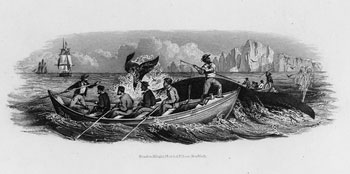Harpooning the Whale
Thousands of whaleboat excursions were successful. Skilled oarsmen sneaked up on their prey and the mate determined that the vessel was within striking distance of the whale. Speaking softly, the mate signaled to the harpooner to put down his oar, step onto a small platform in the bow of the boat, and aim his harpoon. "Give it to him!" he commanded when the boat was as close to the whale as safety allowed. Without a moment's hesitation, the harpooner hurtled the harpoon and was ready with a second iron should this be necessary.
What happened next depended on the whale species and its temperament. Some whales were known for being particularly tame while others resisted capture, leaping and thrashing in pain. Some even turned and attacked the small, wooden whaleboats. Scores of sailors were injured each year when their boats were stove or attacked by an angry, thrashing whale. One crew member recalled when a harpooned whale “pitched the whole weight of her head on the Boat—stove ye boat and ruined her and killed the midshipman outwright a Sad and Awful Providence.”
The harpooner's job was done. He had wounded the whale, which was attached to the whaleboat by long rope tied to the end of the harpoon, which pierced it. Now he climbed over legs, oars and equipment to take the tiller from the mate at the rear of the boat. The mate or boatheader, who outranked the harpooner, clambered to the front of the boat where he would have the honor of inflicting the final, fatal wound with a lance.

Library of Congress